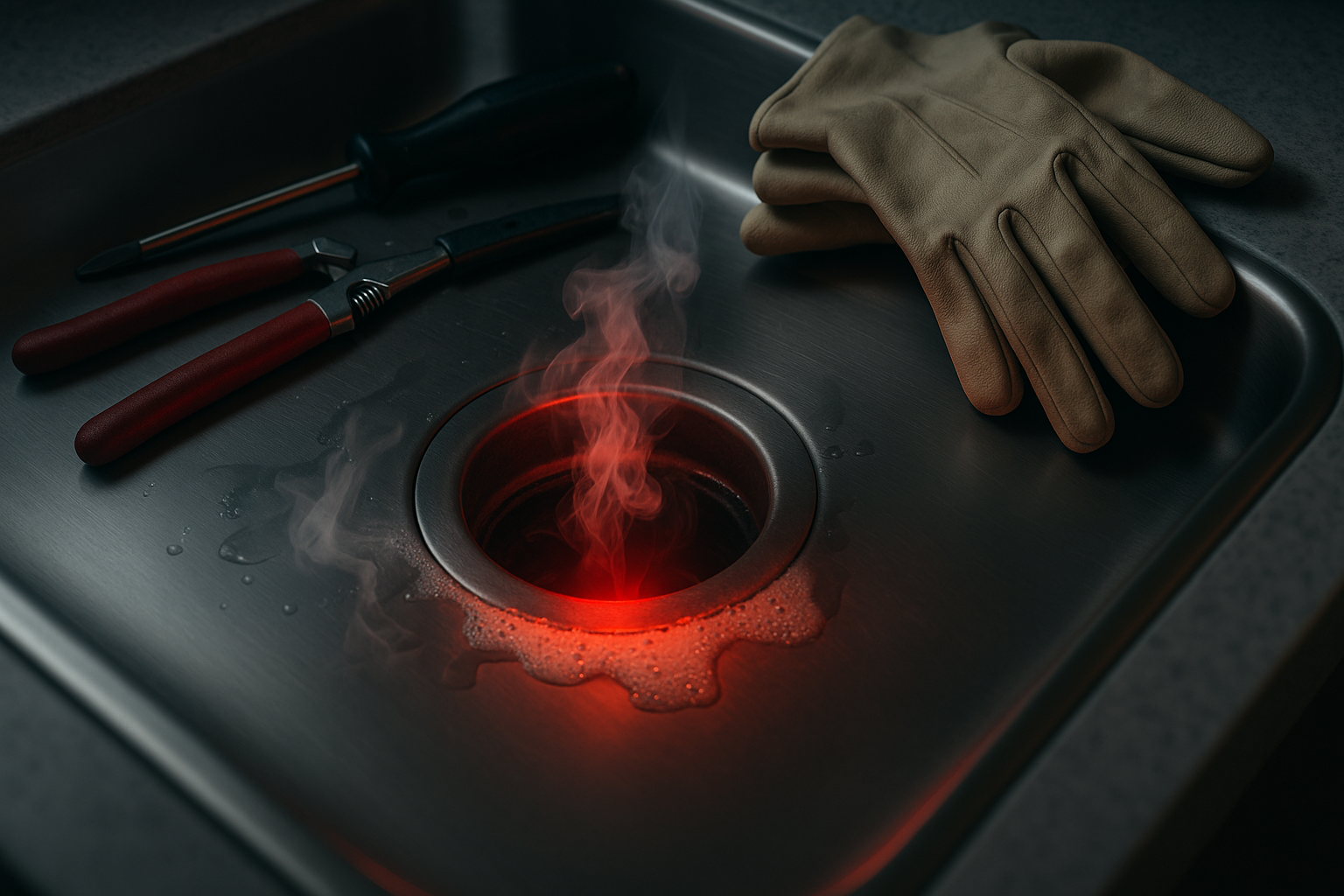A garbage disposal burning smell isn’t just annoying; it’s serious. That sharp odor can be your first warning of a failing motor, jammed food, or burnt grease. If your garbage disposal smells like burning, don’t ignore it. You might prevent significant damage with just a few quick checks and fixes.
In most cases, the burning smell comes from overheating, old wires, stuck food scraps, or mechanical wear. These problems build up quietly until the unit starts smoking or emitting a garbage disposal burning smell. Luckily, you don’t always need a plumber. Knowing what causes it helps you tackle the issue faster and avoid costly replacements.
This guide breaks it all down. We’ll cover the five most common causes of a burning smell from your garbage disposal, and the exact fix for each. Whether you’re dealing with a stuck flywheel or fried bearings, we’ve got you. Read on and address the issue before it damages your unit.
Overheating Motor: The Most Common Cause
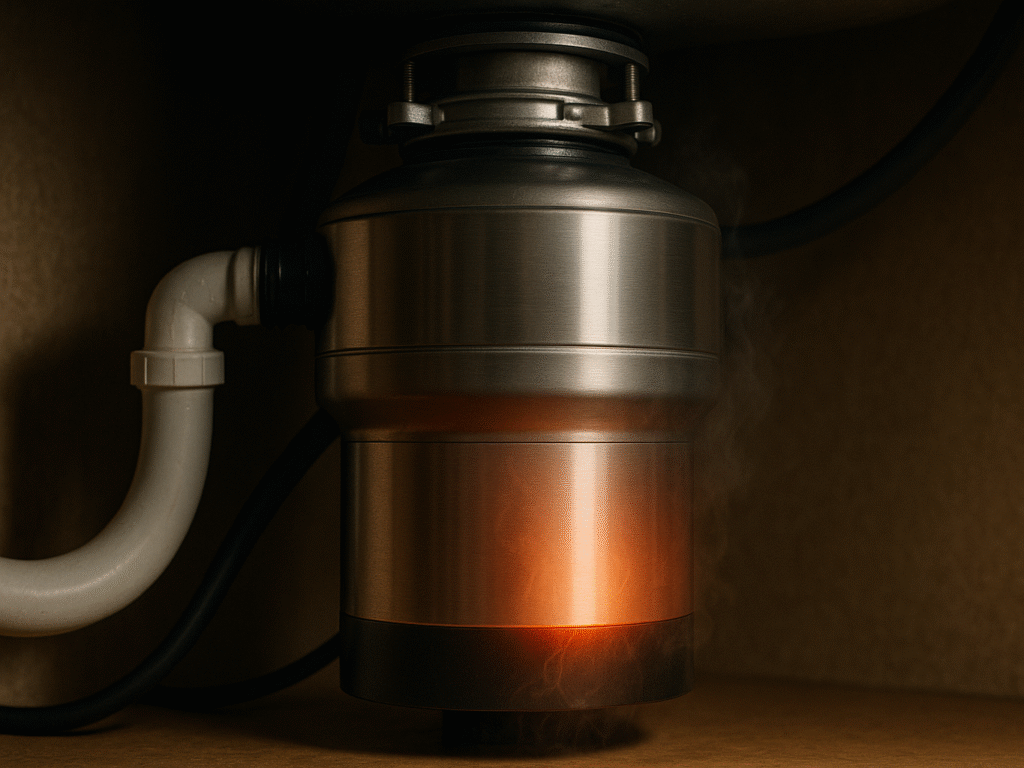
When your garbage disposal smells like burning and suddenly emits that telltale odor, an overheating motor is frequently the culprit. This common issue occurs in many households and, fortunately, can often be resolved without professional help. Understanding why motors overheat and recognizing the warning signs early can prevent a persistent garbage disposal burning smell and save your disposal from permanent damage.
1. Why do motors overheat in garbage disposals?
Garbage disposals don’t run nonstop by design. Extended use, especially with tough foods, can cause the motor to overheat. When it works too hard, heat builds fast. Most disposals aren’t built for that kind of pressure, especially if they’re already dealing with worn or aging parts.
Continuous use without breaks is another big issue. The motor doesn’t get time to cool down. Since it’s tucked under the sink with poor airflow, that trapped heat builds up fast. Back-to-back grinding sessions only exacerbate the problem, and soon the system starts to smell burnt.
Clogs and jams can also cause motors to overheat. When blades can’t move freely due to stuck food or debris, the disposal pulls more power to push through. That extra effort causes severe heat. And in older units with weak motors, it’s a recipe for when your garbage disposal smells like burning every time.
2. Signs your motor is overheating
If your garbage disposal is overheating and producing a burning smell, early warning signs are easy to miss until it’s too late. A burnt smell is usually the first clue, but several other symptoms often go unnoticed. Recognizing these hints early can save your unit from permanent damage.
Signs of Overheating:
- Burning smell
- Humming noise
- Frequent resets
- Warm exterior
- Sudden shutdown
- Intermittent power
- Jammed blades
- Reset won’t work
Ignoring these symptoms can worsen the problem. If multiple signs appear together, your unit likely needs attention. Catching the issue early helps prevent electrical failure, costly repairs, or complete disposal replacement. Always shut off the power before inspecting the device.
How to Eliminate the Smell from Your Garbage Disposal Today: Don’t Let Persistent Odors Ruin Your Kitchen Experience. This comprehensive guide reveals professional techniques for permanently eliminating odors from disposal, with step-by-step solutions for every situation. Learn the proven methods here.
3. Quick Fix: Let the motor cool and reset the unit
Addressing an overheating motor starts with immediate action to prevent further damage. First and foremost, turn off the power to the disposal both at the wall switch and the circuit breaker. This safety step protects both you and the appliance from electrical hazards while you troubleshoot.
Once powered down, allow your disposal adequate time to cool completely, typically 15 to 30 minutes. Rushing this cooling period can result in continued overheating issues when the unit is restarted. During this cooling phase, avoid running water down the drain, as this might impact the internal temperature of the unit.
Most garbage disposals feature a reset button located on the bottom of the unit, facing the floor. This button functions as an overload protector, essentially a circuit breaker specifically for the disposal’s motor. After the cooling period that helps eliminate the garbage disposal burning smell, locate this button (typically red) and press it firmly until you feel or hear it click into place. If the button won’t stay pressed, the unit likely hasn’t cooled sufficiently. Wait another 10 minutes before trying again.
After resetting, restore power to the disposal and test it by running cold water while briefly activating the unit. If it operates normally without unusual noises or smells, the overheating issue may have been temporary. However, if problems persist, turn off the disposal immediately to prevent further damage.
To prevent future overheating incidents, adopt these preventative measures:
- Run cold water before, during, and after using your disposal
- Process food in small batches rather than all at once
- Avoid grinding fibrous or tough items
- Give your disposal short breaks during extended use
- Regularly clean the unit to prevent buildup and obstructions
Understanding that garbage disposals have operational limits is essential. Most household units aren’t designed for continuous heavy-duty use. If your disposal continues to overheat despite following these precautions, consider whether your usage patterns are appropriate for your model’s capabilities.
For persistent overheating issues, especially in older units (8-15 years old), replacement might be more economical than continued repairs. Newer models often feature improved motors with better cooling systems and overload protection, making them less prone to overheating under regular household use.
Remember that an overheating motor can occasionally indicate deeper issues, such as worn bearings, electrical problems, or mechanical failures, that may require professional assessment. If basic troubleshooting doesn’t resolve the burning smell, consulting with a qualified technician might save you from more expensive repairs down the road. For comprehensive solutions to eliminate persistent odors, learn how to eliminate the garbage disposal smell using proven professional techniques.
Food Jam or Hard Object Stuck in the Blades
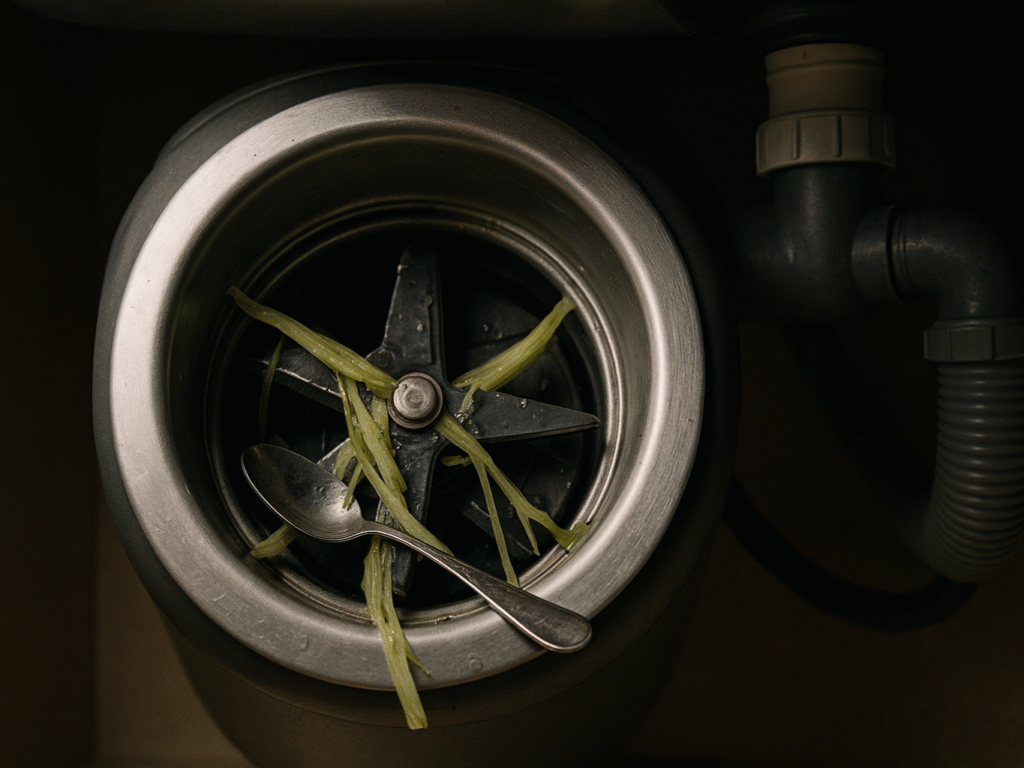
Strange noises followed by a persistent garbage disposal burning smell often indicate that something is stuck in your garbage disposal. Unlike simple overheating, a jammed disposal that makes your garbage disposal smell like burning presents unique challenges that require specific solutions. When foreign objects or food debris become lodged in your disposal’s grinding mechanism, they can quickly transform your kitchen from a pleasant cooking space to a smoke-filled danger zone.
1. How jams cause a burning smell
When an object jams the impeller blades of your garbage disposal, it causes immediate mechanical stress. The motor still receives power, but the blades can’t spin, which builds friction and heat. Over time, this stress can cause significant damage to internal components, ultimately leading to unit failure.
You’ll likely hear a humming sound while the blades remain stationary, indicating a blockage. This sound indicates that the motor is straining, working harder than usual, and is unable to rotate freely. As the motor continues to struggle, it overheats, triggering safety mechanisms and producing a sharp garbage disposal burning smell.
In severe cases, you may even see smoke or notice melted plastic around the unit. That’s a clear sign to cut power immediately. The jammed object forces the motor’s energy to convert into heat rather than movement, damaging wires, bearings, or lubricants and worsening the burning odor.
2. Everyday items that get stuck
Particular objects consistently rank among the most frequent culprits behind disposal jams. Bones from meat products top the list as they’re particularly problematic; disposal blades aren’t strong enough to break them down. Even small chicken bones can wedge between the impeller and disposal wall, creating immediate jams.
Hard seeds and pits from fruits like peaches, nectarines, and cherries similarly pose significant risks. These dense objects can blunt the blades or completely halt your disposal’s operation. Given their size and hardness, they often become firmly lodged in the grinding mechanism.
Fibrous vegetables constitute another category of troublemakers. Items like celery, corn husks, and onion skins (particularly the outer layers) can wrap around the impeller assembly, gradually building up until they restrict movement. The string-like fibers in these foods often become entangled in the blades, causing clogs and operational issues.
The most hazardous are non-food items that accidentally find their way into the disposal and can cause an immediate garbage disposal burning smell. Common culprits include:
- Silverware (especially spoons and butter knives)
- Bottle caps
- Screws or nails
- Cigarette butts
- Rubber bands
- Twist ties
- Paper products
- Sponge pieces
Metal objects present a grave threat. For instance, a spoon jammed in a garbage disposal can create immediate resistance that strains the motor beyond its capabilities. Metal utensils can also damage the disposal’s internal components, potentially creating more expensive repair needs.
How to Stop Your InSinkErator from Smelling: Quick & Easy Fixes: InSinkErator units require specific maintenance approaches for optimal performance. Discover manufacturer-recommended techniques and troubleshooting methods that keep your premium disposal running smoothly without unpleasant odors. Get expert InSinkErator solutions.
3. Quick Fix: Use a hex wrench or broom handle to dislodge
Clearing a jammed disposal requires caution and the right approach. Here’s a systematic process to safely address the problem:
- Power off completely: Before attempting any repair to address the garbage disposal burning smell, disconnect power to your garbage disposal. It means both turning off the wall switch and unplugging the unit or turning off the relevant circuit breaker. Never reach into a disposal without completely cutting the power.
- Inspect the chamber: Use a flashlight to examine inside the disposal through the sink opening. Look carefully for any visible obstructions, paying particular attention to the area around the outer edge of the shredding disk where you see the small teeth. If you spot a foreign object, carefully remove it using tongs or pliers, never your hands.
- Locate the hex socket: Most disposals include a manual turning mechanism at the center of the unit, typically located at the bottom. This hex-shaped socket (usually 1/4-inch) is explicitly designed for unjamming operations. Many disposals come with a specialized wrench for this purpose, often stored nearby or attached to the unit.
- Insert and turn the wrench: Place the hex wrench into the socket at the disposal’s bottom. Work the wrench back and forth in both directions, like a crank. This movement directly rotates the impeller hub and can dislodge whatever is causing the jam. If the wrench won’t turn easily, you can apply moderate force; the wrench is designed to bend before damaging the disposal.
- Alternative method: If your disposal lacks a hex socket or you can’t locate the wrench, you can use a wooden broom handle or similar sturdy wooden implement inserted from above. Place it against one of the impellers and carefully push to rotate the grinding plate. Work it back and forth in both directions until movement feels free.
- Check for freedom of movement: Continue working with the wrench or handle until it turns freely in complete circles in both directions. This indicates you’ve successfully dislodged the obstruction.
- Reset the unit: After clearing the jam, check the small red reset button on the bottom of the disposal (the overload protector). If it has tripped, it will have dropped down about a quarter of an inch. Gently press it; if it doesn’t stay up, wait ten minutes for further cooling before trying again.
- Test operation: Restore power, run cold water, and briefly activate the disposal. If it operates normally without unusual noises, you’ve successfully addressed the jam. If problems persist, repeat the process or consider professional assistance.
To prevent future jams, adopt the following practices: avoid disposing of problematic items such as bones, pits, fibrous vegetables, and grease; always run cold water when using the disposal; process food in small batches; and regularly clean your unit with ice cubes and citrus peels to remove buildup.
Remember that proper usage significantly extends your disposal’s lifespan. By knowing what not to put down at your disposal and responding promptly to jams, you’ll avoid those unpleasant burning smells and potential damage to your valuable kitchen appliance. If you’re dealing with a premium InSinkErator unit, discover specific maintenance techniques designed for these high-performance disposals.
Worn-Out Motor Bearings or Internal Parts
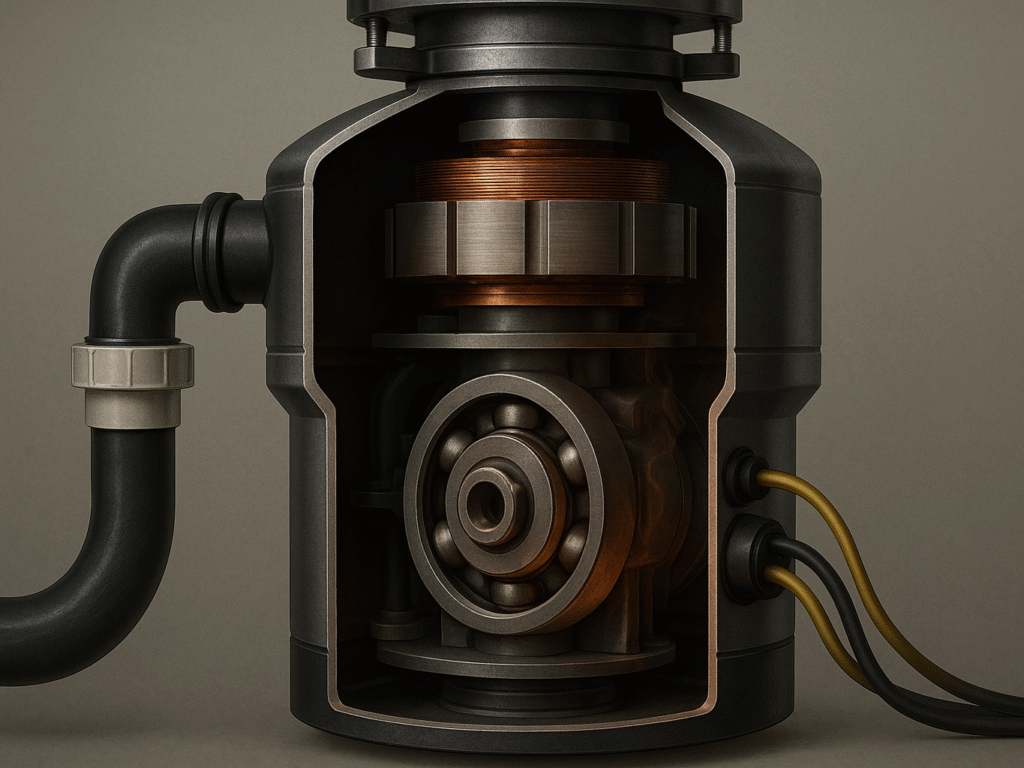
Over time, even the most reliable garbage disposals succumb to natural wear and tear. After years of daily use, the internal components, particularly the motor bearings, begin to deteriorate, creating a distinctive burning smell that differs from temporary issues such as jams or overheating. This more persistent garbage disposal burning smell often signals that your disposal is entering the final stage of its operational life.
1. How wear and tear lead to burning smells
The motor in your garbage disposal relies on bearings to allow smooth rotation of moving parts. These bearings are essentially the unsung heroes of your unit, providing the frictionless environment necessary for efficient operation. Throughout the typical 10-12-year lifespan of a disposal, these bearings endure countless hours of stress.
As these bearings age, they gradually lose their lubricating properties and develop rough spots. Consequently, what was once a smooth, low-friction rotation becomes increasingly resistive. It adds resistance, creating excess heat through friction, much like rubbing your hands together quickly generates warmth. Inside your disposal, this unwanted heat builds up around the motor components.
The persistent garbage disposal burning smell originates when this excessive heat affects various materials inside the disposal:
- Lubricants begin to break down and emit a distinctive “hot oil” smell
- Rubber seals and gaskets start to melt or degrade
- Plastic components near the motor may begin to warp
- Insulation around motor wiring might start to smoke
Unlike the immediate incident when your garbage disposal smells like burning from a jam or single overheating, bearing-related odors typically persist even after the unit cools down. Moreover, this problem progressively worsens with each use, as continued operation accelerates the deterioration process.
2. When bearings start to fail
Recognizing early warning signs of bearing failure helps you address the issue before a complete breakdown occurs. The most telltale indicator is a high-pitched squealing sound coming from your disposal. This noise originates specifically from failing motor bearings and serves as an immediate warning, requiring attention.
Other indicators that your disposal’s bearings are starting to fail include:
- A persistent humming sound without blade movement
- Screeching or metal-on-metal grinding noises
- Increased operating time is needed to process food waste
- The disposal suddenly shuts off during regular use
- Needing to hit the reset button frequently
- A garbage disposal burning smell that doesn’t dissipate after cooling
These symptoms typically don’t appear in isolation. Usually, you’ll notice a progression, starting with occasional squealing that eventually becomes constant, followed by the unit requiring frequent resets, and culminating in persistent burning odors.
The degradation timeline varies based on usage patterns and unit quality. Typically, bearings begin showing signs of wear around the 8-year mark in regularly used disposals. Heavy usage households might experience issues earlier, whereas light users might extend bearing life considerably.
A particularly concerning sign is when your disposal works intermittently, starting and stopping on its own during operation. This pattern usually indicates that the bearings have deteriorated to the point where they’re creating enough resistance to trigger the unit’s internal circuit protection, which cuts power to prevent complete motor burnout.
3. Quick Fix: Consider replacing the motor or unit
Unlike other garbage disposal issues with straightforward DIY solutions, worn motor bearings typically require professional intervention or complete replacement. In most cases, once bearings have failed, continued use risks permanent damage to the motor and other components.
Your first decision point involves determining whether the disposal is worth repairing. Consider these factors:
- Age assessment: If your disposal is approaching or exceeding the average 10-12 year lifespan, replacement generally makes more economic sense than repair. Most professionals recommend replacement when bearing issues arise in units older than 8 years.
- Cost comparison: Repairing motor bearings often costs nearly as much as purchasing a new unit. Replacement parts for internal components can be expensive, and labor adds significantly to the final bill.
- Unit condition: If you’ve noticed other performance issues alongside the bearing problems, such as slow draining, frequent clogs, or leaks, these additional factors favor replacement over repair.
- Availability of parts: Many disposal manufacturers don’t offer bearing replacements as separate parts. In numerous models, the entire motor assembly must be replaced, which is comparable to the cost of a new unit.
If your assessment leads toward replacement, thoroughly disconnect the existing unit before attempting removal. This process involves:
- Turning off power at the circuit breaker (not just the wall switch)
- Disconnecting plumbing connections
- Removing the mounting assembly
Professional installation costs around $100–$200, ensuring your garbage disposal is connected correctly and safely. This option is ideal for households uncomfortable with plumbing work or electrical tasks involving kitchen appliances. Suppose you notice musty odors along with burning smells. In that case, you might be dealing with bacterial growth that requires specialized mold removal techniques.
Upgrading to a modern unit offers benefits such as stronger motors, quieter operation, and enhanced grinding power. Many models come with improved insulation and advanced bearings, which contribute to longer life, making replacement a wise investment for long-term reliability.
Always disconnect power at the circuit breaker before any repair. Water and electricity create serious hazards. Improper fixes can damage components or cause shocks, so safety must be the top priority when handling garbage disposal issues.
Garbage Disposal Smells Like Mold? Here’s How to Clean It Fast: Musty, mold-like odors indicate bacterial growth that standard cleaning can’t eliminate. Learn professional-grade sanitization techniques that destroy harmful microorganisms and restore your disposal to a fresh, clean operation. Eliminate mold odors permanently.
Electrical Short or Wiring Malfunction
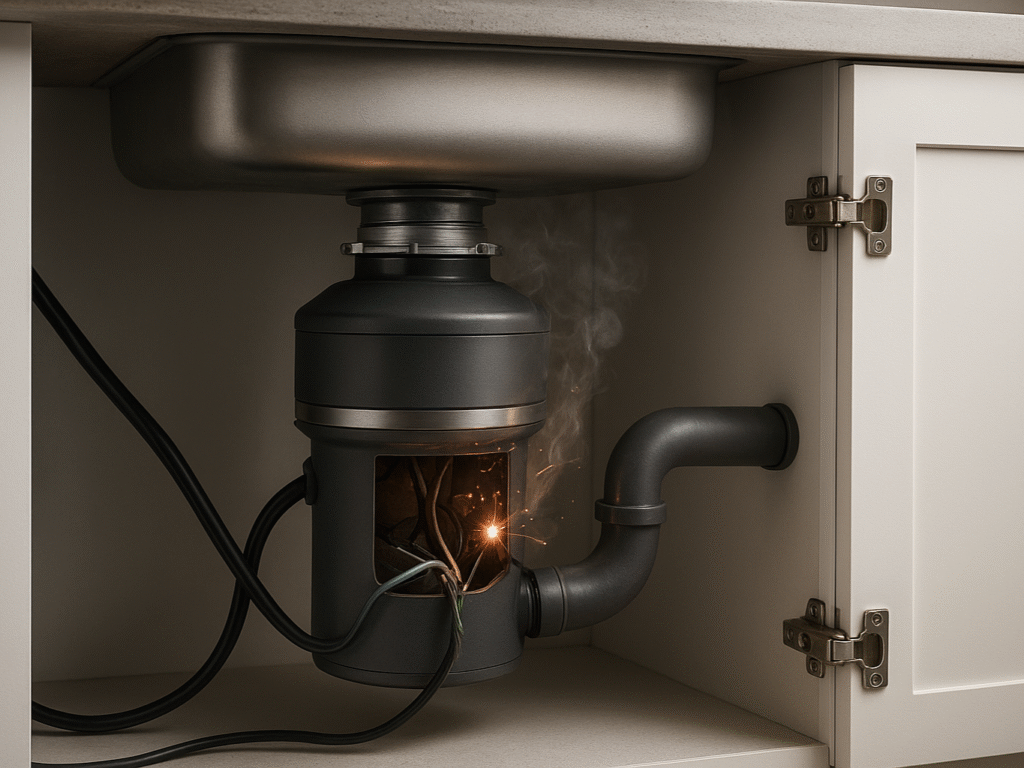
Electrical problems present some of the most hazardous scenarios when dealing with a garbage disposal burning smell. Unlike mechanical issues that might damage your disposal unit, electrical malfunctions pose serious safety risks to your entire household. Understanding the warning signs and knowing how to respond appropriately could be a lifesaving skill in these situations.
1. How faulty wiring causes a smoke or burning smell
Electrical problems in garbage disposals often begin with vibration, which can loosen internal wiring. Heavy loads increase this effect, causing wires to shift or disconnect. These loose connections create heat-generating resistance, making your garbage disposal smell like burning hot metal or melting plastic during operation.
Another issue involves exposed wiring outside the unit’s wire box. Garbage disposals must be kept within a covered metal compartment, with all connections secured. When wires are left exposed, they are at risk of moisture damage and shorts, especially in damp kitchens, which can lead to electrical failure or dangerous sparking incidents.
Faulty grounding or aging outlet circuits also cause problems. If a disposal isn’t properly grounded, shocks or fires may result. Likewise, worn outlets can’t handle repeated surges during startup, creating hot spots and eventually emitting that telltale electrical burning odor.
2. Dangers of electrical issues in disposals
Electrical malfunctions in garbage disposals pose more than appliance issues; they’re significant fire risks. Faulty wiring, exposed outlets, and overheating can ignite kitchen cabinetry. Fires often smolder unnoticed, erupting into flames only after considerable damage has occurred, making early detection and repair essential for safety.
Electric shocks are another significant threat, especially near water sources such as sinks. Improper grounding or exposed wires increases the risk of fatal accidents. Circuit overloads and reversed polarity silently damage home wiring. These issues worsen over time, often manifesting as smoke, odors, or tripped breakers.
Warning signs you shouldn’t ignore include:
- Sparks visible during operation
- Disposal randomly turns off during use
- Circuit breaker tripping when the disposal runs
- Flickering lights when the unit operates
- Plastic or metallic burning scent (distinct from food odors)
- Disposal that works intermittently or requires frequent resets
3. Quick Fix: Check connections or call an electrician
When confronting potential electrical issues, safety must always be your top priority. Begin by completely disconnecting power to the disposal, not merely at the wall switch, but at the circuit breaker. This precaution prevents accidental activation during inspection or repair.
After ensuring power is disconnected, verify using a voltage tester at the disposal’s electrical box. This confirmation step protects against incorrectly labeled breakers or unexpected secondary power sources.
For basic inspection, carefully examine accessible connections:
- Remove the cover plate from the disposal’s electrical box at the bottom of the unit
- Check for loose wires, burn marks, or melted insulation
- Ensure all wire nuts remain securely fastened
- Verify that wiring remains properly color-matched (black to black, white to white)
- Confirm that the ground wire connects correctly to the green terminal
For switch-related issues, inspect the wall switch controlling your disposal:
- Turn off the power at the breaker
- Remove the switch plate
- Unscrew the switch from the electrical box
- Inspect terminal connections and tighten if loose
- Look for burn marks or melting around terminals
Most garbage disposals either plug into a socket under the sink or connect directly to home wiring. For plug-in units, check the cord and outlet for damage. Hardwired systems are more complex and typically require a professional to inspect them safely and securely.
Know your DIY limits. While tightening a loose connection may be possible, deeper wiring problems require the expertise of an electrician. Even if you suspect an electrical fault, call a plumber first; they often spot non-electrical causes. For confirmed electrical issues, hire a licensed electrician to ensure safety and code compliance.
Keep in mind that professional assistance becomes necessary whenever:
- Sparks or smoke appear during operation
- The electrical burning smell persists after simple checks
- Your breaker trips repeatedly despite reset attempts
- You lack confidence in working with electrical components
- The motor seems to be damaged or shows signs of burning
- Your disposal lacks proper grounding
Lastly, prevention remains the best approach. Schedule regular inspections of your disposal’s electrical components, particularly checking for connection looseness that may result from normal vibration. This proactive maintenance helps identify potential issues before they develop into hazardous situations that require emergency intervention.
Grease or Gunk Buildup Burning on Heat
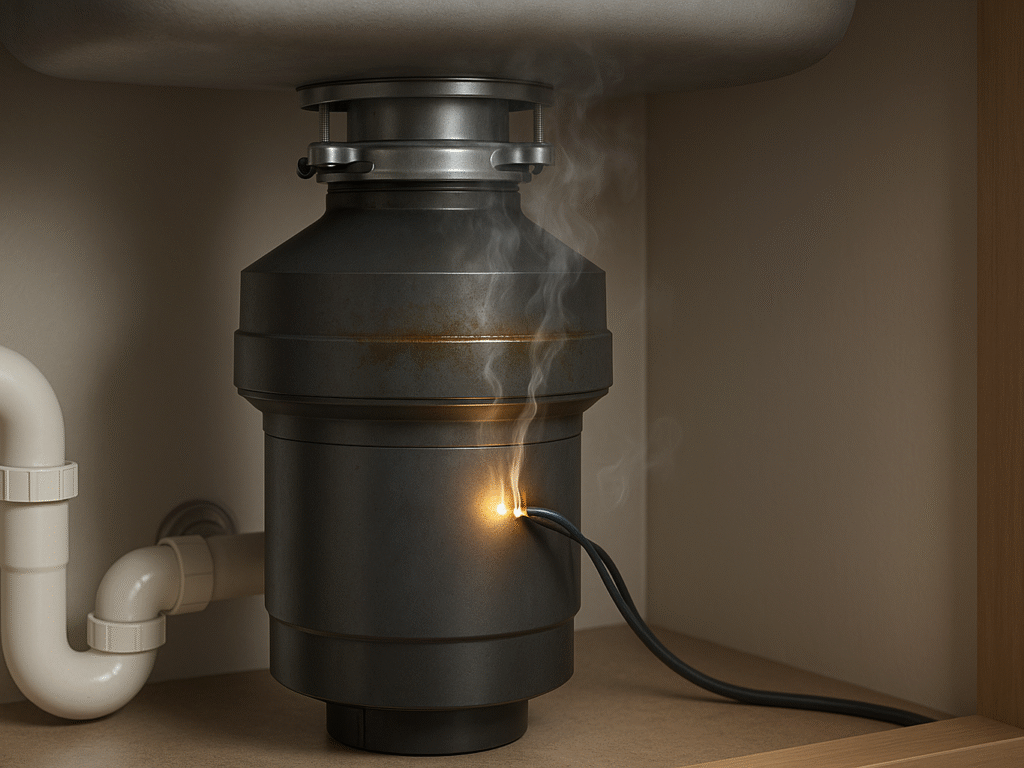
That smoky, burnt smell coming from your garbage disposal might not be a mechanical or electrical failure. Often, the culprit is simply grease and food residue burning on heated components. This common but frequently overlooked issue occurs in many households, yet has one of the easiest fixes.
1. How grease buildup leads to smoke and odor
When grease, oils, and fats go down your garbage disposal, they don’t disappear; they cling to internal components. As these substances cool, they solidify and form a sticky residue on blades and walls. This buildup accumulates over time, coating the disposal’s internal mechanisms and restricting proper function.
Once the motor heats up during operation, this greasy buildup begins to burn, making your garbage disposal smell like burning and creating that distinctive smoke and unpleasant odor. The longer your disposal runs, the hotter it gets, intensifying both the smell and potential smoke. Undoubtedly, this buildup can corrode metal parts if left unaddressed.
How to Get Rid of Garbage Disposal Smell with Ice: A Simple Trick That Works: The ice cleaning method removes stubborn buildup while sharpening blades naturally. This simple technique costs pennies but delivers professional-level results that significantly eliminate odors and improve grinding performance. Master the ice cleaning technique.
2. Foods that contribute to gunk accumulation
Several everyday kitchen items are notorious for creating disposal-clogging residue:
- Cooking oils and grease from bacon, butter, and other fatty substances solidify in pipes
- Starches like pasta and rice that expand and become sticky when wet
- Coffee grounds that accumulate and cause blockages
- Fibrous vegetables such as celery stalks and corn husks
Grease is particularly problematic as it can liquefy when hot water runs through it, potentially creating thicker, stickier substances that can further clog your plumbing.
3. Quick Fix: Clean with ice, vinegar, and citrus peels
Fortunately, removing this buildup is straightforward with these methods:
First, pour two cups of ice cubes and one cup of kosher or rock salt into the disposal. Run cold water while grinding until the mixture is completely processed. The ice and salt act as an effective scrub for the blades.
Alternatively, sprinkle half a cup of baking soda into the disposal, followed by a cup of white vinegar. Let this mixture sit for 5-10 minutes before flushing with hot water.
Finally, grind citrus peels (such as lemon, lime, or orange) with cold, running water. The citrus oils help cut through grease while leaving a fresh scent.
For more effective cleaning, use the ice method, which combines ice cubes with salt to create an abrasive cleaning action that removes stubborn buildup. To prevent future buildup, never pour grease down the disposal; instead, collect it in containers for trash disposal.
Final Thoughts
A garbage disposal burning smell can result from various internal issues, and knowing the cause helps you fix it quickly. Whether your garbage disposal smells like burning due to overheating, food jams, or electrical faults, it’s crucial to act rapidly. Each situation has a different solution and safety risk level.
Overheated motors often need a cooldown and reset, while jammed food can be cleared with a hex wrench. Suppose your garbage disposal smells like burning and is older. In that case, worn bearings may be the culprit, signaling the need for replacement. Electrical problems, however, should always be left to professionals for safety. For persistent odor issues beyond burning smells, explore comprehensive odor elimination methods that address various causes.
Grease buildup is the easiest issue to fix. Use a cleaning combo of ice cubes, rock salt, and citrus peels to freshen things up. Preventative steps, such as weekly cleaning, avoiding fibrous foods, and running cold water during use, help prevent a burning smell in a garbage disposal before it starts—small habits, significant impact.
FAQs
Q1. What causes a burning smell from a garbage disposal?
A burning smell often indicates an overheating motor, electrical issues, or debris that has become stuck. If your garbage disposal smells like burning, turn it off immediately to avoid further damage and inspect for signs of friction, jamming, or wiring problems.
Q2. How can I fix an overheating garbage disposal motor?
Unplug the unit, let it cool for 15–30 minutes, and press the reset button underneath. Flush with cold water while briefly turning it on. It resolves temporary overheating but may not help if your garbage disposal has a burning smell from deeper electrical faults.
Q3. What should I do if my garbage disposal is jammed?
Turn off the power, then inspect inside using tongs or pliers. Insert a hex wrench into the bottom slot to manually turn the motor and dislodge clogs. After clearing the jam, restore power and press the reset button to restart the device.
Q4. How can I clean grease buildup in my garbage disposal?
Pour in ice cubes and kosher salt to scrub away debris. Follow with baking soda and vinegar for deep cleaning, then grind citrus peels under cold water to freshen the unit. Regular cleaning helps prevent odors and ensures blades function properly.

